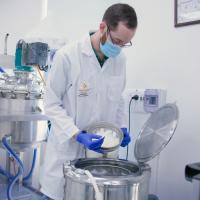Would you eat a lab-grown chicken nugget? In Singapore, some diners already are. The nation recently became the first to approve the commercial sale of lab-grown chicken, which was produced by the U.S.-based food company Eat Just. It marked a major step for lab-grown meat, a form of cellular agriculture that’s been developing on the fringes of the food world for years.
Lab-grown meat isn’t a plant-based alternative that mimics the look and taste of chicken, beef, or fish. It’s real meat. The key difference is that lab-grown meat doesn’t require raising and slaughtering animals.
By growing meat in labs, we could not only provide a new way to feed a growing population, but also make the meat industry more sustainable, less cruel, and potentially safer.
The Convincing Benefits of Lab-Grown Chicken
Why produce lab-grown chicken? First consider the animal: humans slaughter about 50 billion chickens every year, and that’s not counting hens that die during commercial egg production. In the U.S. and most other nations, meat chickens and egg-laying hens aren’t protected by animal welfare laws.
It’s worth considering that our moral biases toward chickens might need recalibrating. After all, chickens are pretty neat creatures. A 2017 review found that the flightless birds show cognitive, emotional, and social intelligence that rival many of the animals we strive to protect: monkeys, cats, and even dolphins. Chickens also seem capable of empathy, dreaming, problem-solving, and understanding object permanence.
Yet most chickens spend their lives in crowded warehouses on factory farms. These warehouses can pack as many as 20,000 birds, each of which is often confined to a space the size of a piece of paper. The conditions are disgusting. With nowhere to go, chickens are trapped atop a toxic layer of urine and feces.
Humans slaughter about 50 billion chickens every year.
The waste from factory farms can harm farmworkers and pollute the atmosphere as well as local water supplies. Chickens raised in factory farms can also pollute us: bacterial outbreaks can spread easily among the birds, and humans who eat the meat can then contract foodborne illnesses. Worse, some of these infections can’t be treated with antibiotics because factory farms have overused antibiotics on chickens.
“There’s a reason why we don’t eat raw chicken these days, because many times it has salmonella, it has a lot of fecal matter that happens during cross contamination, during the slaughtering process,” Vítor Espírito Santo, director of cellular agriculture at Eat Just, told Freethink. In contrast, the company’s lab-grown chicken is produced in a clean and controlled environment.
“Because we are decoupling all of that in this new production system, our product is very sterile,” Santo said. “We don’t use antibiotics in any stage of production.”
Contaminants and antibiotics aside, what about the nutrition of this synthetic meat? It’s hard to say, exactly, because scientists still have much to learn about how lab-grown meats differ from conventional meats from a nutritional perspective. What’s more, lab-grown meat can be engineered to have different types or amounts of vitamins, minerals, and bioactive compounds, meaning the nutritional profile of the meat would vary by producer.
Lab-grown meat isn’t a plant-based alternative that mimics the look and taste of chicken, beef, or fish. It’s real meat.
But it’s possible that lab-grown meat will be more nutritious than plant-based alternatives. Plant-based meat products aren’t always healthier than conventional meats; they often pack a ton of salt, saturated fat, and additives. They also undergo a lot of processing, which strips the plants of much of their health benefits.
The environmental impacts of lab-grown meat are a bit more clear cut. Although the process does require electricity, it could significantly reduce pollution and deforestation caused by the meat industry because the process doesn’t require housing, feeding, and transporting billions of animals every year.
But the most revolutionary aspect of lab-grown meat arguably comes down to ethics. After all, to grow chicken meat in the lab, you don’t need to take a bird’s life. Just a feather will do.
The Making of Lab-Grown Chicken
Growing meat in a lab starts with a single cell. For example, the first meat Eat Just produced started with a cell extracted from a feather that belonged to an especially healthy chicken named Ian. Today, Eat Just gets its cells from a cell bank, and obtaining them doesn’t require slaughtering any animals.
The chicken cells are fed plant nutrients to establish a healthy culture of cells, called a cell line. These cell lines are then placed in 1,200-liter bioreactors which are sealed steel containers that control climate and pressure. This environment acts like the body of a chicken, allowing the cells to grow and multiply exponentially. After about two weeks, the cells become edible animal tissue, in the form of raw minced meat.
This bioreactor acts like the body of a chicken, allowing the cells to multiply exponentially. After about two weeks, the cells become edible animal tissue.
Eat Just then forms the tissue into certain shapes like fillets or nuggets. In Singapore, the company’s first lab-grown chicken product was a nugget, or “chicken bite.” But Eat Just and similar companies could also use 3D printers to create all sorts of familiar cuts using lab-grown meat. For example, Aleph Farms makes a lab-grown ribeye and SuperMeat makes a chicken burger.
Coming Soon to a Restaurant Near You
Although the technology to produce cell-cultured meat exists today, the industry still faces hurdles. According to the global consulting firm Kearney, 35% of all meat will be grown in labs by 2040. But in order for that to happen, the lab-grown meat industry needs to scale up and reduce retail costs.
In 2013, the Dutch scientist Mark Post unveiled the world’s first cultivated meat hamburger. It cost about $325,000 to produce. By 2018, Memphis Meats was selling a quarter-pound of lab-grown beef for $600. And in late 2020, Eat Just’s chicken bites sold for $17 per portion at Singapore’s 1880 restaurant.
Still, reaching price parity with conventional meat products will require the lab-grown meat industry to build bigger bioreactors, and more of them. As the industry scales, the first affordable lab-grown meat products will likely be simple food structures, like Eat Just’s chicken nuggets.
Producing more complex foods — like a steak with fat and bones — is possible, but it requires sophisticated tissue-engineering approaches that are prohibitively expensive today. But that could change soon.
“Once there is engagement with the market, we’ll see bigger and bigger factories rise up, and that will allow us to lower the cost,” Josh Tetrick, Eat Just’s founder and CEO, told Food Business News. “The complexity isn’t high. It’s just a matter of investing the resources and the focus.”
Technology aside, are consumers willing to entertain the idea of switching from conventional to lab-grown meat? It seems likely. A 2021 study published in the journal Foods found that 80% of respondents in the U.S. and U.K. would be willing to try lab-grown meat, while another survey found that most consumers would be willing to pay a hefty premium for cultivated meat, some at a premium of nearly 40%.
Today, lab-grown meat is only available in Singapore and a handful of noncommercial test restaurants, such as The Chicken in Tel Aviv. But lab-grown meat will likely become more common if other nations follow Singapore’s footsteps.
Kearney predicts 35% of all meat will be grown in labs by 2040.
“The race to divorce meat production from industrial animal agriculture is underway and nations that follow Singapore’s lead will be able to reap the benefits as the entire world shifts to this new and better way of making meat,” Elaine Siu, a managing director at the Good Food Institute, said in a statement.
Lab-grown meat probably won’t replace conventional meat any time soon. But it could carve out a sizable niche for itself in the meat industry, helping to reduce animal suffering and environmental devastation.
The fate of lab-grown meat depends not only on advances in technology, but also on us shifting how we think about meat. Then again, our palates may have the final say, and the industry’s success could depend on consumers declaring the old cliche: “tastes like chicken.”


